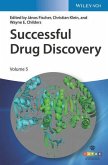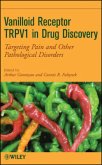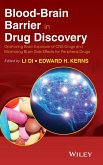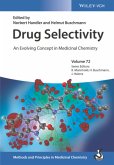Trends in CNS Drug Discovery
Herausgegeben:Doller, Dario; Hodgetts, Kevin; Fischer, János; Klein, Christian; Childers, Wayne E.; Rotella, David P.
115,99 €
inkl. MwSt.
Versandkostenfrei*
Erscheint vorauss. 24. September 2025
Melden Sie sich
hier
hier
für den Produktalarm an, um über die Verfügbarkeit des Produkts informiert zu werden.

58 °P sammeln
Trends in CNS Drug Discovery
Herausgegeben:Doller, Dario; Hodgetts, Kevin; Fischer, János; Klein, Christian; Childers, Wayne E.; Rotella, David P.
- Gebundenes Buch
Trends and challenges in one of the largest areas of contemporary drug development - presented by industry professionals with a track record of discovering new drugs and treatments.
Andere Kunden interessierten sich auch für
![Successful Drug Discovery Successful Drug Discovery]() Successful Drug Discovery110,99 €
Successful Drug Discovery110,99 €![Vanilloid Receptor TRPV1 in Drug Discovery Vanilloid Receptor TRPV1 in Drug Discovery]() Arthur GomtsyanVanilloid Receptor TRPV1 in Drug Discovery245,99 €
Arthur GomtsyanVanilloid Receptor TRPV1 in Drug Discovery245,99 €![Blood-Brain Barrier in Drug Discovery Blood-Brain Barrier in Drug Discovery]() Blood-Brain Barrier in Drug Discovery175,99 €
Blood-Brain Barrier in Drug Discovery175,99 €![Drug Discrimination Drug Discrimination]() Richard A. GlennonDrug Discrimination200,99 €
Richard A. GlennonDrug Discrimination200,99 €![Peripheral Receptor Targets for Analgesia Peripheral Receptor Targets for Analgesia]() Brian E. CairnsPeripheral Receptor Targets for Analgesia208,99 €
Brian E. CairnsPeripheral Receptor Targets for Analgesia208,99 €![Drug and Therapy Development for Triple Negative Breast Cancer Drug and Therapy Development for Triple Negative Breast Cancer]() Drug and Therapy Development for Triple Negative Breast Cancer102,99 €
Drug and Therapy Development for Triple Negative Breast Cancer102,99 €![Drug Selectivity Drug Selectivity]() Drug Selectivity170,99 €
Drug Selectivity170,99 €-
-
-
Trends and challenges in one of the largest areas of contemporary drug development - presented by industry professionals with a track record of discovering new drugs and treatments.
Produktdetails
- Produktdetails
- Trends in Drug Discovery 2
- Verlag: Wiley-VCH
- Artikelnr. des Verlages: 1135280 000
- 1. Auflage
- Seitenzahl: 480
- Erscheinungstermin: 24. September 2025
- Englisch
- Abmessung: 244mm x 170mm
- ISBN-13: 9783527352807
- ISBN-10: 3527352805
- Artikelnr.: 72751258
- Herstellerkennzeichnung
- Wiley-VCH GmbH
- Boschstraße 12
- 69469 Weinheim
- wiley.buha@zeitfracht.de
- 06201 6060
- Trends in Drug Discovery 2
- Verlag: Wiley-VCH
- Artikelnr. des Verlages: 1135280 000
- 1. Auflage
- Seitenzahl: 480
- Erscheinungstermin: 24. September 2025
- Englisch
- Abmessung: 244mm x 170mm
- ISBN-13: 9783527352807
- ISBN-10: 3527352805
- Artikelnr.: 72751258
- Herstellerkennzeichnung
- Wiley-VCH GmbH
- Boschstraße 12
- 69469 Weinheim
- wiley.buha@zeitfracht.de
- 06201 6060
Dario Doller earned a Ph.D. in Organic Chemistry from the Facultad de Ciencias Exactas y Naturales, UBA, Argentina. He conducted postdoctoral studies with Sir Derek Barton at Texas A&M University. His industrial career includes Rohm & Haas, Schering-Plough Research Institute, 3-Dimensional Pharmaceuticals, Gliatech, Neurogen, Lundbeck, CoNCERT, Sage, Sunovion Pharmaceuticals, Lucy Therapeutics, and iNeuro Therapeutics, where he is currently director of medicinal chemistry. He contributed to the discovery of the marketed PAR-1 antagonist vorapaxar and the clinical compounds NGD-4715, Lu AF09535, and CTP-692. He coauthored over 100 articles, patents or patent applications, and book chapters, and edited the book Allosterism in Drug Discovery. Current interests include molecular concepts at the chemistry/biology interface to enhance the translatability of preclinical research.
PART 1: CURRENT STATUS AND THERAPY OVERVIEW
Drug discovery in the Century of Biology
Academic vs. Industrial CNS drug discovery: An evolving relationship
The role of Venture Capital in drug discovery
Spin-off companies
The NIH role catalyzing the discovery of novel treatments
PART 2: KEY QUESTIONS FOR CONTEMPORARY CNS DRUG DISCOVERY
The end: defining CNS diseases (molecular vs phenotype)
Target selection in the treatment of CNS diseases
The use of animal models in brain drug research
Biomarkers in CNS drug discovery
PET imaging in CNS drug discovery
PART 3: PSYCHEDELIC-INSPRIRED DRUG DISCOVERY
Update on ketamine, esketamine, arketamine
Non-hallucinogenic antidepressants
Cannabinoids as therapeutics for brain disease
PART 4: UNION MAKES STRENGTH: COMBINING DRUGS TO PRODUCE NOVEL CNS THERAPEUTICS
Xanomeline-trospium for schizophrenia
Olanzapine-samidorphan
Dextromethorphan-bupropion
Levodopa prodrug
Apomorphine
PART 5: EMERGING CHEMICAL MODALITIES FOR BRAIN DISEASES
PROTACs in CNS drug discovery
Small molecule allosteric modulators
Progress using biologics drugs for CNS diseases (CGRP migraine, Anti-amyloid antibodies, MSA/PD and a-SYN antibodies)
Using mechanistic studies for CNS diseases
What is the best surrogate of brain penetration?
Brain cancer treatments (brain penetration of kinase inhibitor)
PART 6: EPILOGUE
Treating brain disease in the next decade
Drug discovery in the Century of Biology
Academic vs. Industrial CNS drug discovery: An evolving relationship
The role of Venture Capital in drug discovery
Spin-off companies
The NIH role catalyzing the discovery of novel treatments
PART 2: KEY QUESTIONS FOR CONTEMPORARY CNS DRUG DISCOVERY
The end: defining CNS diseases (molecular vs phenotype)
Target selection in the treatment of CNS diseases
The use of animal models in brain drug research
Biomarkers in CNS drug discovery
PET imaging in CNS drug discovery
PART 3: PSYCHEDELIC-INSPRIRED DRUG DISCOVERY
Update on ketamine, esketamine, arketamine
Non-hallucinogenic antidepressants
Cannabinoids as therapeutics for brain disease
PART 4: UNION MAKES STRENGTH: COMBINING DRUGS TO PRODUCE NOVEL CNS THERAPEUTICS
Xanomeline-trospium for schizophrenia
Olanzapine-samidorphan
Dextromethorphan-bupropion
Levodopa prodrug
Apomorphine
PART 5: EMERGING CHEMICAL MODALITIES FOR BRAIN DISEASES
PROTACs in CNS drug discovery
Small molecule allosteric modulators
Progress using biologics drugs for CNS diseases (CGRP migraine, Anti-amyloid antibodies, MSA/PD and a-SYN antibodies)
Using mechanistic studies for CNS diseases
What is the best surrogate of brain penetration?
Brain cancer treatments (brain penetration of kinase inhibitor)
PART 6: EPILOGUE
Treating brain disease in the next decade
PART 1: CURRENT STATUS AND THERAPY OVERVIEW
Drug discovery in the Century of Biology
Academic vs. Industrial CNS drug discovery: An evolving relationship
The role of Venture Capital in drug discovery
Spin-off companies
The NIH role catalyzing the discovery of novel treatments
PART 2: KEY QUESTIONS FOR CONTEMPORARY CNS DRUG DISCOVERY
The end: defining CNS diseases (molecular vs phenotype)
Target selection in the treatment of CNS diseases
The use of animal models in brain drug research
Biomarkers in CNS drug discovery
PET imaging in CNS drug discovery
PART 3: PSYCHEDELIC-INSPRIRED DRUG DISCOVERY
Update on ketamine, esketamine, arketamine
Non-hallucinogenic antidepressants
Cannabinoids as therapeutics for brain disease
PART 4: UNION MAKES STRENGTH: COMBINING DRUGS TO PRODUCE NOVEL CNS THERAPEUTICS
Xanomeline-trospium for schizophrenia
Olanzapine-samidorphan
Dextromethorphan-bupropion
Levodopa prodrug
Apomorphine
PART 5: EMERGING CHEMICAL MODALITIES FOR BRAIN DISEASES
PROTACs in CNS drug discovery
Small molecule allosteric modulators
Progress using biologics drugs for CNS diseases (CGRP migraine, Anti-amyloid antibodies, MSA/PD and a-SYN antibodies)
Using mechanistic studies for CNS diseases
What is the best surrogate of brain penetration?
Brain cancer treatments (brain penetration of kinase inhibitor)
PART 6: EPILOGUE
Treating brain disease in the next decade
Drug discovery in the Century of Biology
Academic vs. Industrial CNS drug discovery: An evolving relationship
The role of Venture Capital in drug discovery
Spin-off companies
The NIH role catalyzing the discovery of novel treatments
PART 2: KEY QUESTIONS FOR CONTEMPORARY CNS DRUG DISCOVERY
The end: defining CNS diseases (molecular vs phenotype)
Target selection in the treatment of CNS diseases
The use of animal models in brain drug research
Biomarkers in CNS drug discovery
PET imaging in CNS drug discovery
PART 3: PSYCHEDELIC-INSPRIRED DRUG DISCOVERY
Update on ketamine, esketamine, arketamine
Non-hallucinogenic antidepressants
Cannabinoids as therapeutics for brain disease
PART 4: UNION MAKES STRENGTH: COMBINING DRUGS TO PRODUCE NOVEL CNS THERAPEUTICS
Xanomeline-trospium for schizophrenia
Olanzapine-samidorphan
Dextromethorphan-bupropion
Levodopa prodrug
Apomorphine
PART 5: EMERGING CHEMICAL MODALITIES FOR BRAIN DISEASES
PROTACs in CNS drug discovery
Small molecule allosteric modulators
Progress using biologics drugs for CNS diseases (CGRP migraine, Anti-amyloid antibodies, MSA/PD and a-SYN antibodies)
Using mechanistic studies for CNS diseases
What is the best surrogate of brain penetration?
Brain cancer treatments (brain penetration of kinase inhibitor)
PART 6: EPILOGUE
Treating brain disease in the next decade







